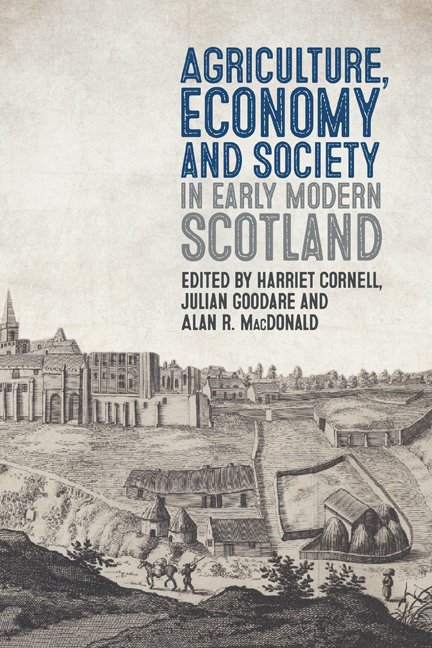Book contents
- Frontmatter
- Dedication
- Contents
- Illustrations
- Contributors
- Acknowledgements
- Note on Currency and Measures
- Abbreviations
- Map of Scotland
- Introduction: Exploring Scotland’s Agricultural History
- 1 Imagining Scottish Agriculture before the Improvers
- 2 The Use of Dykes in Scottish Farming 1500–1700
- 3 The Famine of 1622–23 in Scotland
- 4 Weather and Farming through the Eyes of a Sixteenth-Century Highland Peasant
- 5 Stock, Fermes, Mails and Duties in a Midlothian Barony 1587–89
- 6 The Roots of Improvement: Early Seventeenth-Century Agriculture on the Mains of Dundas, Linlithgowshire
- 7 ‘God Knowis my Sleipis ar Short and Unsound’: Andro Smyth’s Collection of Rent, Tax, Teind and Tolls in Shetland c.1640
- 8 Farming in the Stirling Area 1560–1750
- 9 What Were the Fiars Prices Used For?
- 10 Agriculture and Banking in Eighteenth-Century Scotland 1695–1750
- 11 Capitalism’s Cradle? Ideas, Policies and the Rise of the Scottish Economy in the Mercantilist Age 1600–1800
- Conclusion: A Historiographical and Bibliographical Overview
- Index
- Boydell Studies in Rural History
9 - What Were the Fiars Prices Used For?
Published online by Cambridge University Press: 14 May 2024
- Frontmatter
- Dedication
- Contents
- Illustrations
- Contributors
- Acknowledgements
- Note on Currency and Measures
- Abbreviations
- Map of Scotland
- Introduction: Exploring Scotland’s Agricultural History
- 1 Imagining Scottish Agriculture before the Improvers
- 2 The Use of Dykes in Scottish Farming 1500–1700
- 3 The Famine of 1622–23 in Scotland
- 4 Weather and Farming through the Eyes of a Sixteenth-Century Highland Peasant
- 5 Stock, Fermes, Mails and Duties in a Midlothian Barony 1587–89
- 6 The Roots of Improvement: Early Seventeenth-Century Agriculture on the Mains of Dundas, Linlithgowshire
- 7 ‘God Knowis my Sleipis ar Short and Unsound’: Andro Smyth’s Collection of Rent, Tax, Teind and Tolls in Shetland c.1640
- 8 Farming in the Stirling Area 1560–1750
- 9 What Were the Fiars Prices Used For?
- 10 Agriculture and Banking in Eighteenth-Century Scotland 1695–1750
- 11 Capitalism’s Cradle? Ideas, Policies and the Rise of the Scottish Economy in the Mercantilist Age 1600–1800
- Conclusion: A Historiographical and Bibliographical Overview
- Index
- Boydell Studies in Rural History
Summary
The old minister had died of drink … and his last words were, so the story went, and what might the feare's prices be today?
– Lewis Grassic Gibbon, Cloud Howe (1933), ch. 1Fiars prices have long been appreciated as an analytical tool by Scottish economic historians, who have used them to construct price series for grain and meal, and to enable studies in market integration. But the question has seldom been asked in any depth – what were they originally for? How were the fiars used by contemporaries?
Let us first remind ourselves of what the fiars prices were. They apparently emerge in the sixteenth century. Gemmill and Mayhew's account of Scottish medieval prices makes no mention of them, but there is a passing reference in the Register of the Great Seal for 1524 to an annual price known as ‘le feir’ having been used in the Glasgow region for at least ten years beforehand. They were intended to be a factual statement of the average market price of various grains (and of meal) within a county, since the preceding harvest. They were normally ‘struck’ (calculated) by a legal process before a court sitting in February. They are of uncertain origin: the word ‘fiar’ is accepted to be allied to ‘forum’, and to mean ‘market’, so ‘fiars price’ means ‘market price’. Their main legal basis was custom and practice; neither the Scottish parliament, nor, after 1707, the British parliament, ever legislated to make fiars mandatory. However, the fiars acquired a firm institutional basis through becoming attached to various other administrative and commercial procedures. This chapter will investigate those procedures.
Sixteenth-century sources refer to fiars being struck by Commissary Courts, but later the surviving fiars seem invariably to have been drawn up in the Sheriff Courts. For a time in the seventeenth century, Commissary and Sheriff fiars seem sometimes to have been in existence together. Although there are no surviving examples of rival lists, in a case involving the parish of Edrom in Berwickshire in 1696 the Commissary fiars were preferred over the Sheriff fiars because the dispute involved the sale of teinds. The earliest extant fiars series is one for Fife, for the period 1556–86, followed by a gap until 1619. More series follow the reform of the teinds in the 1630s, but only after 1708 do they become general for Scottish lowland counties.
- Type
- Chapter
- Information
- Agriculture, Economy and Society in Early Modern Scotland , pp. 199 - 215Publisher: Boydell & BrewerPrint publication year: 2024



